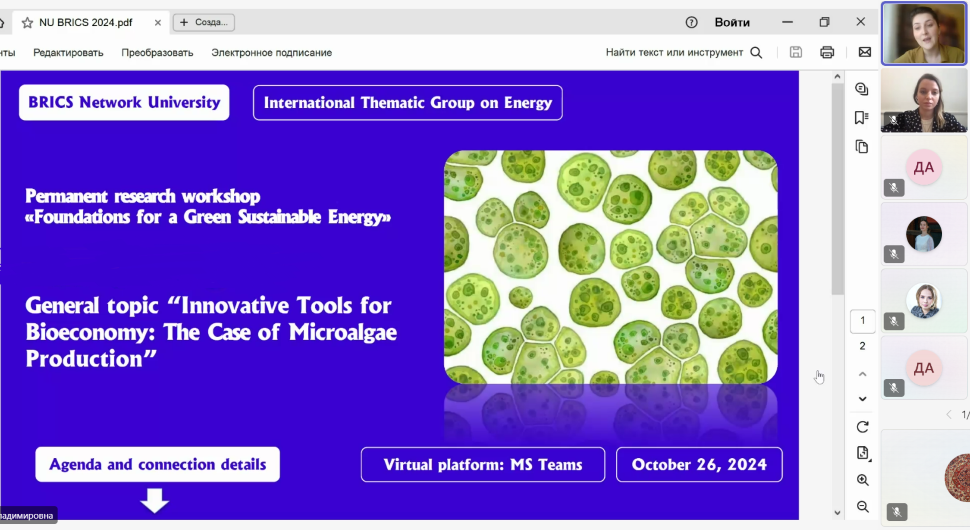Microalgae - an innovative bioeconomy tool

The series of scientific seminars is conceived to inform postgraduate students and young scientists from BRICS Network University member universities about scientific problems solved by partner universities and to attract them to participate in international academic mobility.
The main speaker of the seminar was Irina Adarchenko, a graduate student from the Institute of Environmental Engineering at RUDN University with the presentation “Innovative Tools for Bioeconomy: the case of microalgae production.”
Microalgae are a source of valuable bioresources: proteins, lipids, carbohydrates, vitamins and other useful substances. However, their production is a multi-stage process.
First, microalgae are cultivated under controlled conditions, whether in open ponds, closed photobioreactors or fermenters. The biomass grown in this way is then harvested and dehydrated. In order to release the cell contents, it is necessary to break down the cell walls. Mechanical, chemical and enzymatic methods are used for this purpose. Next, extraction takes place where organic solvents, alkalis, acids and enzymes are used to extract specific substances. The extracts obtained are separated and purified to isolate the target products.
For example, high-purity proteins are extracted using alkaline extraction or enzymatic hydrolysis, and omega-3 fatty acids are extracted by lipid extraction with organic solvents and subsequent separation. Vitamins and natural pigments are extracted using specialised solvents. Antioxidants and other specific substances are extracted using solvent extraction and chromatography.
Proteins, lipids and carbohydrates derived from microalgae can be used in the food industry. For example, as additives, ingredients for functional foods and aquaculture feeds. Vitamins, pigments, antioxidants and other bioactive compounds - in pharmaceuticals, cosmetics and food supplements. In the energy industry, lipids are used for biodiesel production and carbohydrates for bioethanol. In agriculture, microalgae biomass becomes biofertiliser. In addition, microalgae are used for wastewater treatment as well as in the production of biodegradable plastics.
Microalgae have been used in the bioeconomy for several reasons:
- They have a high growth rate, which allows them to produce biomass in large quantities in a short time.
- They do not occupy arable land as they are cultivated in culture media.
- They can absorb CO2 from the atmosphere, reducing the greenhouse effect.
- They can be used for bioremediation, treating wastewater and polluted areas.
- The variety of microalgae species, each with a unique composition, provides the opportunity to produce a variety of products.
Microalgae have great potential to address both food and environmental security issues. Microalgae are increasingly being used for bioremediation and biofuel production. An important aspect of developing effective solutions is the selection of microorganisms. Therefore, research to identify new strains of microalgae that have unique properties such as mixotrophy is particularly relevant now.
Microalgae provide proteins and micronutrients to the population, solving the global problem of food security. They also play an important role in energy security. They provide renewable sources of biofuels, reducing dependence on fossil fuels. The prospects for the utilisation of microalgae are linked to the development of new technologies for cultivation, processing and scale-up of production. In the future, we should expect the emergence of new microalgae-based bioproducts and the expansion of their use in various industries.
There are several technologies for cultivating microalgae:
- Open ponds are the most economical option, although they do not provide complete control over growth conditions.
- Closed photobioreactors provide more controlled conditions, high productivity and biomass purity, but their cost is significantly higher.
- Hybrid systems combine elements of open ponds and closed photobioreactors to optimise the production process.
- Fermenters, which are used to grow some microalgae species in the dark using organic substrate.
The implementation of these technologies in production involves a number of problems and challenges. For example, due to the high cost of production, significant investments in equipment and infrastructure are required. The low productivity of some strains and processing technologies requires further optimisation and scaling up. Cultivation and processing processes are energy intensive, so more efficient and environmentally friendly methods must be sought. The risk of eutrophication of water bodies when using microalgae in bioremediation requires strict control. In addition, there are problems in scaling up laboratory developments to industrial production, as well as difficulties in logistics and storage of biomass and the resulting products.
The project to develop a cellular model of the placenta became the winner in the Scientific Materials category of the Young Scientists 3.0 competition, organized with the support of the Presidential Grants Foundation and T-Bank.
Ten scientific journals published by RUDN University have been included in the highest level of the state list of scientific publications, the White List.
Forests are not only the lungs of the planet, but also home to millions of species. However, it has remained unclear how underground interactions between trees and fungi affect forest species richness in different climatic conditions. Previous studies have yielded conflicting results: in some regions, the dominance of certain fungi reduced tree diversity, while in others it increased it.
The project to develop a cellular model of the placenta became the winner in the Scientific Materials category of the Young Scientists 3.0 competition, organized with the support of the Presidential Grants Foundation and T-Bank.
Ten scientific journals published by RUDN University have been included in the highest level of the state list of scientific publications, the White List.
Forests are not only the lungs of the planet, but also home to millions of species. However, it has remained unclear how underground interactions between trees and fungi affect forest species richness in different climatic conditions. Previous studies have yielded conflicting results: in some regions, the dominance of certain fungi reduced tree diversity, while in others it increased it.